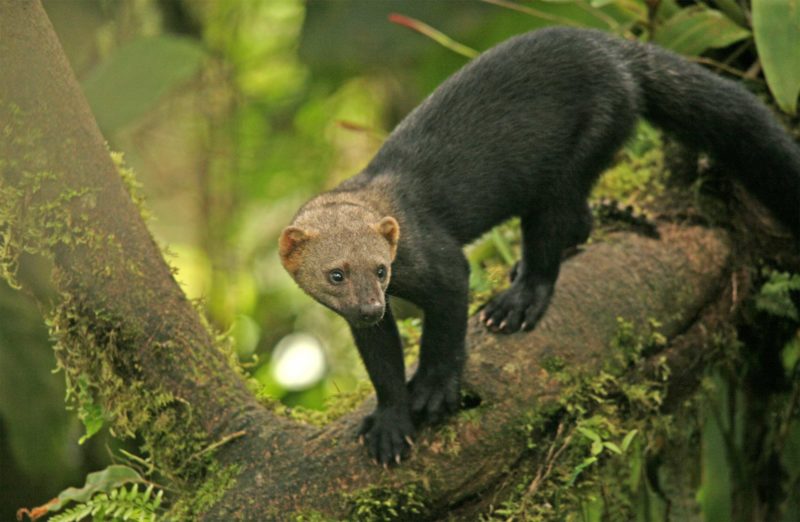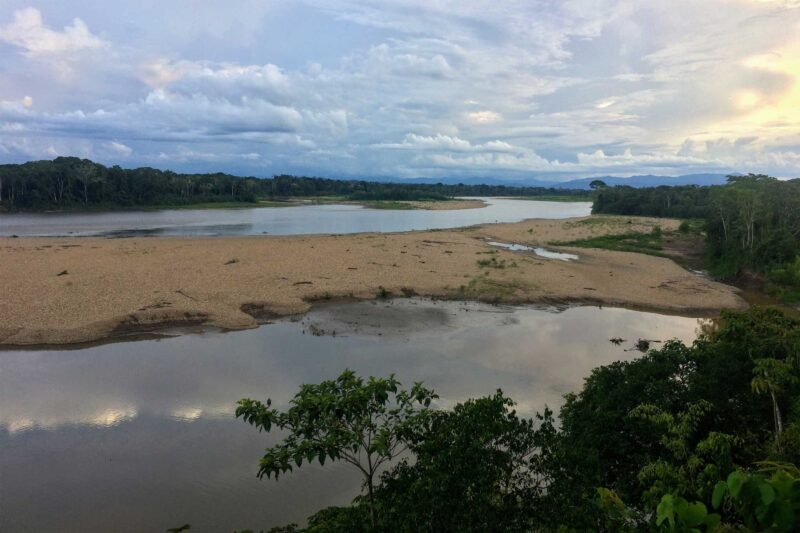Sitting quietly, staring out onto to the partially illuminated trees in front of me, a thick mist begun to roll in, further obscuring my already limited view through the dense Ecuadorian cloud forest. This sharpened my senses for any movement I could make out in the gloom and my mind started to wonder what this curious, nocturnal and arboreal relative of the raccoon; the olinguito would really look like.
I was waiting on a balcony of the Bellavista Cloud Forest Lodge, right in the heart of the Reserve of the same name which protects 700 hectares of species rich pre-montane “Choco” forest on the lower slopes of the Western Andes Mountains. This whole area was very recently designated as a Biosphere Reserve by UNESCO, further safeguarding its future as it is regarded as one of the planet’s greatest biodiversity hotspots.

(The cloud forest of the Bellavista Reserve in Ecuador)
On my first night looking for the olinguito, another member of the raccoon family (Procyonidae) the endearing kinkajou came by to munch through the offering of bananas placed on the edge of the forest for nocturnal visitors. On the second night an Andean white eared opossum was the first visitor.

(Kinkajou in the Bellavista Cloud Forest)

(Andean white-eared opossum emerging from the mist)
It was not until around 22:00 in the night when another slender and light footed creature of the night appeared out of the shadows. This time I could make out the more elongated face and bushier tail of the olinguito. Unlike the kinkajou which has a prehensile tail, this beautiful animal reminded me much more a marten in its appearance and behavior, being very agile and bounding from branch to branch with ease. Once she found the bananas placed in the trees she wasted no time in tucking in to them and I was fortunate to be able to spend an hour watching this relaxed individual, a female known as white tip.

(Olinguito at the Bellavista Lodge – a female known as white tip)
Back in 2013, the olinguito hit the headlines as it was officially recognized as a distinct species and named as the first new species of carnivore (although they mostly eat fruit) to be identified in the Western Hemisphere in 35 years. It is very closely related and similar in appearance to the olingos, which are found in other regions of Central and South America, but the olinguito was under the radar until fairly recently. They have only been recorded in the wild at a few protected areas in Colombia and Western Ecuador including Bellavista Reserve and are thought to be a cloud forest specialty, restricted to a small region.
It was a joy to watch this fantastic mammal during the night and I eventually left to go to sleep still with a beaming smile on my face. It is worth noting that if you are keen to see an olinguito then ideally staying three nights at the Bellavista Lodge would be best as they are not always nightly visitors and can be also shy when they do put in an appearance. There are thought to be seven different individuals that visit the bananas here on and off, alongside several kinkajous, the opossum and during the day “the Wolverine of South and Central America”, the powerfully built tayra also comes by.

(Tayra surveying the scene for food in the cloud forest)
We were lucky enough to catch up with a family of five tayra during their morning jaunt close to the lodge where they stopped by to clean up the remaining bananas from the night before.
Bellavista Reserve and the cloud forest ecosystem as a whole is most famous for its birding. It can often be hard to know where to look especially when visiting a hummingbird feeder or stumbling across a mixed species feeding flock of tanagers during the winter months. The region is one of the most bird rich habitats on the planet with many Western Andean and Choco endemic birds to seek. Even if you are not into all of the harder to see little birds, it is impossible not to be wowed by the birds here. With the likes of the dazzling plate-billed mountain toucan, azure jay, masked trogon, golden-headed and crested quetzals and that most outrageously colourful of species; the toucan barbet, the birdlife here is something special indeed.

(A beautiful male masked trogon sings at dawn next to the lodge)

(The brightly coloured toucan barbet is a highlight)
On a day trip from Bellavista, we visited the now world famous Paz Las Aves Reserve where within minutes of arrival you can be greeted by the spectacle of excited male Andean cocks- of-the-rocks performing for females at their lek. This is a feast for the eyes and ears with some incredible sounds coming from the jostling males, particularly when a female shows interest.
After breakfast here you can meet some of the most elusive denizens of this forest such as the giant, orchre-breasted and yellow-chested antpittas, dark-backed woodquails and so many hummingbirds and tanagers that you will so lose count.

(Maria – the giant antpitta seen in the Paz Las Aves Reserve)

(The gorgeous violet-tailed sylph)

(An inquisitive golden-naped tanager in the Paz Las Aves Reserve)
Once the birds start quieting down you can turn your attention to the vast array of plants. With giant tree ferns, impressive bromeliads and some of the greatest diversity of orchids on the planet, there is beautiful flora around every corner too.

(The camouflaged O’Shaughnessy’s Anole in the Bellavista Cloud Forest Reserve)
A visit to this beautiful corner of Ecuador will leaving you wishing you could stay a whole year to unlock even more secrets of its mysterious forests. Staying at wonderful conservation focused lodges such as Bellavista also really help to fund the protection of more forest for the future.


















